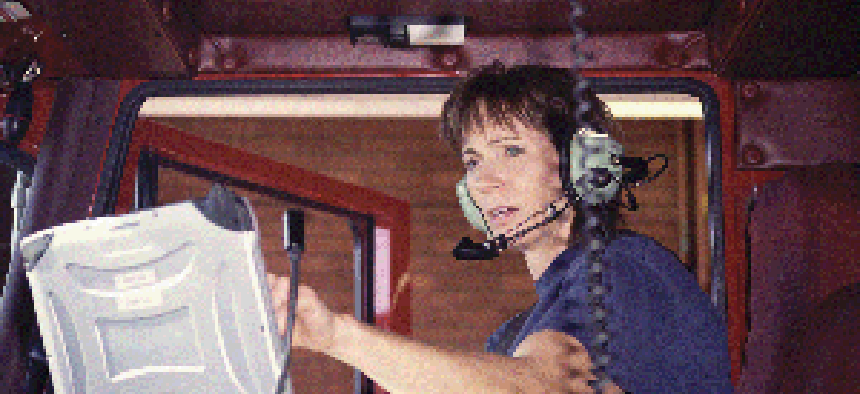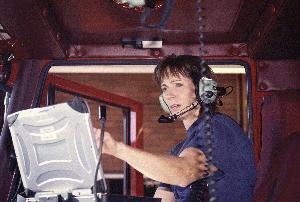Ready for disaster

As the storm surge began to spill over and lay waste to New Orleans' levees, the flood waters wiped out much of the city's communications systems that the wind and rain hadn't destroyed.
As the storm surge began to spill over and lay waste to New Orleans' levees, the flood waters wiped out much of the city's communications systems that the wind and rain hadn't destroyed.Mississippi's Gulf Coast didn't fair any better. But despite the devastation, a little more than a week after the storm, Steve Anspach had eight phone lines ready to go within 20 minutes of getting to a K-Mart parking lot in battered Bay St. Louis, Miss."I left for Mississippi with about four hours notice, and had the phone lines up and operational for more than five days," said Anspach, vice president of technology and engineering for TeleCommunication Systems, Annapolis, Md., which makes satellite communications products.Improving communications in a disaster zone is one of the cornerstones of an effort to avoid the mistakes of Hurricane Katrina."Ensure situational awareness by establishing rapid deployable communications" is one of the recommendations in a White House report on how to strengthen the federal response to disasters.While the chain-of-command politics will be debated for some time, experts said the technology exists now to quickly collect and send information back to a central command.Whether it's voice, video or data that needs to be relayed to a central command center, the key need is establishing a connection with the outside world. In most cases, that means a satellite link to the public Internet or another IP-based network.Duluth, Ga.-based DataPath Inc. supplies Earth terminal satellite systems for military, civilian and commercial customers. The DataPath 3000, for example, is a trailer-based terminal that provides first responders with secure communications at sites that can be reached with a vehicle. It can be customized to support multiple communications bands.For a more remote area, the company has a satellite terminal that can be carried in a Humvee. The DataPath ET 2000 Portable weighs less than 600 pounds and comes in six cases. It can be assembled in less than an hour.An even more portable solution is TeleCommunication Systems' SwiftLink DVM-90. The satellite terminal can be set up in 20 minutes, is software-driven and is shipped in two carry-on sized containers. Its IP-data rates are adjustable from 64 Kb/s to 2.4 Mb/s."It gives the user the ability of literally going anywhere in the world at any time, with absolutely no notice, and immediately upon getting on the ground establishing a communications channel back to their enterprise, home station or just to the general public Internet," Anspach said.The entire package weights about 80 pounds and is transported in two backpacks."You basically unpack the system, connect three cables, apply power to it, push a button and it deploys," Anspach said. "It finds the satellite you're going to operate on, it will acquire it, and it will eventually lock on it."Once a communications connection is made, first responders need access to make phone calls, conduct videoconferences and send data, among other things.Around the beginning of the Iraq war, Cisco Systems Inc. and CACI International Inc. of Arlington, Va., began developing a mobile communications kit to fill that need, said Bob Browning, a senior manager at Cisco for tactical operations support.NetHope, a philanthropic initiative involving several international, non-governmental organizations that apply information and communication technologies to humanitarian causes, heard about the project and funded the construction of six tactical communications kits."We were in the process of finishing those kits when the tsunami hit Indonesia and India. We literally rushed them into production and gave them to organizations such as Save the Children and World Vision," Browning said. "They took them into the tsunami area and used them for initial and ongoing communications until the infrastructure started coming back up."The unit includes routing, switching, security, IP telephone and fax and secure phone capability. The IP phone can also communicate with a radio that lets disparate radio systems to talk to each other.It has a 16-port Ethernet switch module for wired and wireless capability."It looks like a regular large suitcase," Browning said. "It's airline checkable and weighs a little less than 70 pounds."The kit has its own power supply, and it runs off 110 or 220 AC volts, 50 to 60Hz, or 12 or 20 DC volts."In the case of the folks that took it to Sri Lanka, they actually hooked it right to battery terminals and ran it off of that," Browning said.When the unit is on, about 35 people can use it to connect laptops, IP phones and videoconferencing equipment, depending on the bandwidth available.Once communications links are established, organizing users quickly can become difficult. Engineers might be e-mailing photos of damaged infrastructures, while medical workers are using a VoIP phone to request medical supplies.Pacific Star Communications Inc., Portland, Ore., has built a communications appliance that delivers mobile voice and data wireless LAN, streaming video and digital private branch exchange capabilities in an encrypted environment. The PacStar 5500 is housed in a small, portable, field hardened case.And to assist with quickly deploying a team to a remote location, it comes with management software aimed to simplify the process for things such as sending systems alerts to specified administrators or adding new users."This would replace a VoIP phone system, firewall and encryption capabilities and the switching and routing capabilities," said PacStar CEO Robert Frisbee. "If you were in the field, and you had those devices and wanted to add a user, you'd have to go into a number of those devices and add users."With PacStar's software, if you want to add a user, a wizard is used to simplify the process. "The goal is to eliminate the need for IT staff in the field and enable very rapid, advanced communications capability," Frisbee said.To use the unit, first responders have to load the PacStar software on their portable computers."If a National Guard unit ended up at a New Orleans parish, they would hand out the discs with the PacStar software to everyone with a wireless laptop," Frisbee said. "Once it's installed, the wireless laptops are immediately part of the system. You can provide them with a USB phone, and then it's a phone system."Users can be managed in a hierarchical manner, so, for example, a colonel calling a command center in Washington would get the bandwidth necessary to do that over a lesser important call or data transfer."This becomes their communications capability," Frisbee said. "And it becomes both the local communications capability and a link back to a secured Internet site and to headquarters."Staff Writer Doug Beizer can be reached at dbeizer@postnewsweektech.com.

Making the connection
Get organized

Rescue workers rely on mobile communications to respond to disasters.
Morey Milbradt
Making the connection
Get organized
NEXT STORY: Doubts don't hinder e-passport debut